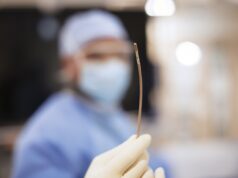
In a new study using optical coherence tomography (OCT), researchers have found that maximum lipid arc and the presence of lipid plaque contralateral to the side branch (SB) ostium before stenting may contribute to significant side branch ostium stenosis (SBOS) after stenting.
The results of the ORBID study were presented as a late-breaking clinical trial at the Society for Cardiovascular Angiography and Interventions (SCAI) 2016 Scientific Sessions in Orlando, USA.
Stenting in the main vessel can result in significant SBOS, making it important for interventional cardiologists to be able to identify at-risk patients before they undergo percutaneous coronary intervention. Significant SBOS is defined as a blockage of 50% or more based on angiography. ORBID study researchers aimed to identify predictors of significant SBOS before a stent is introduced in the main vessel, using OCT, which is in the research-phase for this application.
“When inserting a stent into the main vessel of a patient, we have the option of also inserting a wire in the side branch in case SBOS occurs,” says Samin Sharma, an investigator of the study and director of clinical cardiology and intervention, dean of international clinical affiliations, and president of the Mount Sinai Heart Network, The Mount Sinai Hospital (New York, USA). “In our study, OCT proved helpful in identifying predictors of SBOS prior to PCI, which may allow for avoiding inserting a wire in the side branch in select cases.”
The prospective single-centre study analysed 30 patients who did not have initial blockage in the SB ostium. Post-stenting significant SBOS was observed in 30% of patients. Affected patients were characterised by a higher prevalence of lipids in the blood (100% vs. 64%, p=0.04) and spotty calcifications (60% vs. 0%, p=0.005).
A multivariate logistic regression analysis identified maximal lipid arc (odds ratio [OR]: 1.014, p=0.038) and the presence of lipid plaque contralateral to SB ostium (OR: 8.14, p=0.046) before stenting as independent predictors of significant SBOS.
“This initial study indicates that OCT is a helpful tool in identifying predictors of significant SBOS in patients before they receive a stent,” says Sharma. “In the future, this imaging technology could be broadly introduced as a tool to identify at-risk patients, thereby giving interventional cardiologists more information before doing bifurcation stenting.”













